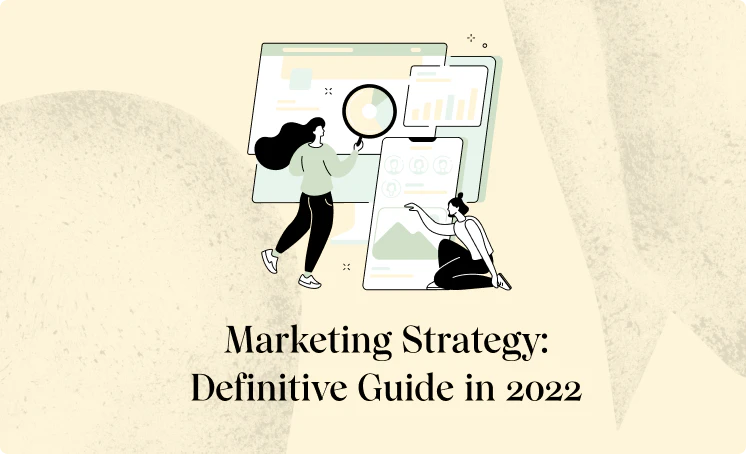Introduction
Not understanding what email marketing metrics to track is why some business owners will tell you email marketing hasn’t worked for them.
Email marketing works if you know what metrics are valuable in relation to your goal. If you’re only looking at the basic open and click-through rates across all subscribers to measure results, you need to keep reading.
What Are Email Marketing Metrics?
Email marketing metrics are data points you should monitor to inform your email marketing strategy.
You’ve likely heard of metrics like open and click-through rates, but there’s more to email metrics than that.
Email marketing metrics provide you a wealth of information starting from lead capture through the entire customer lifecycle. The key is knowing what metrics to track and when they matter to get the most out of your email marketing.
How to Know Which Email Metrics Are Important
This article will cover a multitude of email marketing metrics, but the metrics you should be paying the most attention to will vary by your email campaign goal.
The importance of the data will change based on the lens through which you view it, and you need to keep that in mind when making decisions.
Lead Generation
If you’re using webinars, guides, ebooks, or any asset your prospects must sign up for with their email to access; you can use email metrics to gauge how successful that method of lead generation is for your business.
Specifically, you’ll want to pay attention to how many new subscribers that offer generates to start. Then take a look at the delivery email’s open rate.
That first email delivering your asset will likely have your highest open rate.
If it doesn’t, then you know that 1) your audience wasn’t that excited about what they signed up for, 2) your email subject line and preview information weren’t clear enough, or 3) your email isn’t ending up in your lead’s inbox.
This information can help you adjust your lead generation strategy so that you aren’t missing potential customers.
You may also want to watch the unsubscribe rate after that first email. Some leads will unsubscribe immediately after receiving what they signed up for if they don’t believe that you will continue to deliver new value.
To prevent this, make sure you build anticipation for what’s next in each communication.
Customer Acquisition
Now that you’ve got them on your email list, you should start to focus on what actions they are taking in response to your emails.
You’ll want to watch to learn things like what percentage of subscribers convert, how long it takes them to convert, and what types of emails they respond to.
You can learn the open and click-through rates of each email to determine what types of subject lines and calls to action work well with your audience.
Once your leads turn to customers, you’ll want to start tracking their purchasing patterns and overall revenue per subscriber. This will help you calculate how valuable each subscriber is so you can set informed budgets for lead generation.
Customer Retention
You know that it’s easier and more cost-effective to keep a customer than to keep finding and converting new customers.
Email is an ideal way to help with customer retention. It is less expensive than retargeting ads in most cases and simple to track. Plus, the customers on your list have asked to hear from you, so they are more likely to be receptive to your offers.
You’ll want to pay attention to how engaged they are with your emails, if their action over time is staying consistent or dropping off, and the average length of time someone is on your list.
Being informed will allow you to spot problem areas that you can address to keep more customers.
30 Email Marketing Metrics to Track in 2022
Now that you know understanding the goal of the email campaign is just as important as understanding the metrics, let’s look at 30 email marketing metrics you need to track.
1. Open Rate
Your open rate is one of your more straightforward metrics to understand. It’s simply the percentage of your list that opened your email.
Or, if you want to look at your average open rate, you can add all the percentages and divide them by the number of emails sent.
Whatever email service provider you are using should track and report this metric for you.
On average, you should aim for around a quarter of your list to open your emails.
2. Click-Through Rate
The click-through rate is another metric that is likely available to you from your email service provider.
Your click-through rate will measure what percentage of the people opening your email have clicked a link (or button) in your email.
As you can imagine, this percentage is generally considerably lower than your open rate. Average click-through rates can be as low as 1-2% for some industries, but ideally, you can keep yours above 4%.
Remember that your conversion rate will be lower than your click-through rate, so you want to get as many clicks as you can from each email.
3. Mobile Open Rate

It’s common knowledge that people are checking their emails from their mobile devices more.
Even if you are in the B2B space, busy professionals often turn to their phones to catch up on emails during times when they aren’t at their desks.
You need to track how many of your emails are being opened on mobile versus desktop.
Does your mobile open rate increase during the evenings and weekends? Then you need to optimize any emails you send during these times for mobile by keeping them shorter and to the point. This metric can guide the design of your emails.
4. Mobile Click-Through Rate
Again, the mobile click-through rate works just like the overall click-through rate, except it pulls out the data from mobile specifically.
It’s essential to understand if your customers are clicking through and buying from mobile or if they are opening your email initially on mobile but then moving to the desktop to purchase.
Older audiences may tend to prefer to shop and purchase from a desktop, even if they check their email on their mobile devices.
Learning the nuances of how your customers engage with your emails can make a world of difference in your email marketing results.
5. Domain Open Rate
Spam filters are a nightmare for email marketers. While they are meant to help create a better experience for the user, they often result in legitimate emails being missed.
When preparing your emails, there are some things you can do to try to avoid the spam filter, like choosing to omit words such as “free” or “now,” but every email services’ spam filter is different.
Since there are no streamlined rules, and the rules are constantly changing anyway, you need to watch for problems with specific domains.
If you notice that subscribers with email addresses ending in yahoo.com aren’t opening, it’s likely your email hit their spam filter. Now you need to figure out why to prevent it from happening again.
6. Domain Click Rate
Aside from email experts, many people don’t know that emails render differently depending on your audience’s email service.
For example, Microsoft Outlook is notoriously difficult to design for compared to other services like Gmail.
Even if your email is making it through an email service’s spam filter, the email might not look the way you intended resulting in lower click-through rates for subscribers using a particular email service.
Always include a link to view the email in a browser, just in case.
7. Total Opens vs. Unique Opens
There may be instances where you send an email your subscriber wants to see, but it isn’t a good time, so they mentally flag it to return to it later.
If your total opens is greater than your unique opens, this is probably the reason.
You’ll need to look at data like the day of the week that these emails are initially opened. Look for a pattern that would indicate that a specific day is not ideal for your audience.
For example, Monday mornings are rarely a good time to send a marketing email. People are distracted and don’t want one more thing to think about while preparing for the week ahead.
8. Opening Time
The time your emails are opened can provide insight into when your subscribers want to hear from you.
Are most of your emails opened after 6:00 p.m.? That tells you that your subscribers are busy during the day, and you need to send your emails in the evening and on weekends.
Try to consider your target market’s lifestyle to test the response at different times of the day.
9. Top Openers
Over time, you’ll begin to notice that some subscribers are more likely to open your emails than others.
Many email marketers refer to this group as their VIP subscribers.
Subscribers that open your emails aren’t just more likely to buy; they help keep you in other subscribers inboxes by telling their email service that you provide valuable information worth opening.
To capitalize on these subscribers, you may want to send them exclusive content and offers to reward them for their support and encourage them to continue to open.
10. Long-Term Open Rate
It’s common for subscribers to open every email when they first sign up, but then they may start to lose interest.
If you know the average length of time a subscriber continues to open your emails before they start to get distracted by other things, you can try to re-capture their attention right before this point.
This is a metric you may need to track independently of your email marketing software.
11. Link Clicks
Link clicks are different than click-through rates because a subscriber could click multiple links within one email.
This metric will tell you how many total link clicks were performed from the subscriber, either clicking separate links or clicking the same link multiple times, indicating a high level of interest.
Some email marketers recommend including only one link per email, but the recent surge in email newsletters with lots of links indicates that this is worth testing with your audience.
12. Unsubscribes
The CAN-SPAM act requires that every marketing email you send must include an option to unsubscribe from future emails.
This is why your audience has to sign up for your email list, and you can’t randomly cold email a list of emails you purchase from another source.
If people are signing up to receive emails from you and then unsubscribing a short time later, you need to evaluate if you’re targeting the correct audience or if you need to adjust what you include in your emails.
13. Unsubscribe Rate Per Email
Monitoring your unsubscribe rate per email is a valuable metric to check a few days after each email send.
If an email suddenly sees a spike in unsubscribes, you know you need to evaluate the content of the email to avoid having it happen again.
Some businesses believe that sending too many emails will result in more unsubscribes, but if each email is valuable to your audience, they may not mind.
You need to test your email marketing content and frequency to learn what your customers, or specific segments of your customers, want.
14. Subscribers vs. Unsubscribers
When building up your email list, you’re trying to gain more subscribers than you are losing.
You want people to sign up to your list and then stay on your list, at least through your customer lifecycle.
Are you getting plenty of new subscribers but then quickly losing them? You need to check to see that what they are signing up for matches what you are sending and that you are providing enough value and anticipation to make them want to stick around.
15. Conversions
Conversion rate is the metric that gets the most focus from email marketers because it tells you how effectively the emails have done their job.
After all, the point of email is to guide your subscribers to take action.
Pay attention to which types of campaigns get the most conversions and what, if any, build-up was used before them.

16. Conversions Over Time
At some point, even your most loyal customers will start to convert less.
They may have purchased everything you have to offer, or they may no longer fit your audience. People’s circumstances and interests change, and as they do, so do the things they purchase.
You want to monitor how many times your top customers convert before they start to fall off. Knowing this number will allow you to know when to stop chasing customers in the future.
17. Purchase Rate
Your purchase rate is separate from your conversion rate because a conversion is not necessarily a purchase.
The purchase rate will tell you how many completed sales can be attributed to your email marketing.
18. Return On Ad Spend
Your audience will need to find your sign-up to get on your list and spend money. Ads are a great way to help them do that.
But you’ll want to track how much it costs you per new subscriber to be sure you are maintaining profitability once you add in the cost of creating and sending your email campaigns.
Too often, marketers look at ad spend but forget that sending email has a cost as well.
Once you’ve added the cost of email to the advertising costs, then you can determine your accurate return on ad spend from that segment of subscribers.
19. Revenue Per Open Email
Revenue per open email allows you to see the power of one sales-focused email.
Your revenue per email will likely cover a large range because not all emails are designed to get sales. You’ll want to note how the emails that were sent with the goal of getting a purchase perform over the customer relationship emails.
You might be surprised to find out how much revenue is generated from those emails as well.
20. Revenue Per Subscriber
By tracking how much a subscriber spends, you can learn which segments of your email list are more valuable than others.
When you know the traits of the subscribers that spend more, you can refine your targeting to attract more customers who look like your best subscribers.
21. Time Spent Viewing Email
Some email campaigns are short and to the point, so the time spent viewing the email will be low.
On the other hand, some email marketers use their emails to tell stories, share articles, or give updates on recent company news. These are the emails you want to find out how long your customers are paying attention to.
The open rate of these emails doesn’t tell you how long those people kept reading. If the time spent viewing the email is too short, you know you didn’t capture the reader’s attention.
Once you know how your email list responds to longer emails, you can hone in on what length of emails you send.
22. Active Audience
Email service providers may charge you per subscriber, so you want to make sure the people on your list are active. Otherwise, you are wasting a portion of your email marketing budget for nothing.
Besides money, your inactive audience is dragging down your other metrics like open rate, which could hurt your deliverability.
Track how active each subscriber is and clean your list of inactive subscribers at least every three months.
23. Warm Reply Rate
You may be sending emails without thinking about getting a reply. Email marketing is seen as a one-sided conversation by many.
But this shouldn’t be your mindset.
Email is, above all, a way for two people to communicate on a personal level. You should want your subscribers to respond to your email with questions or concerns.
Replying to your email is another indicator to email service providers that emails from you are well received and should be in your audience’s inbox.
Ensure that the mailbox your subscriber’s replies land in is manned by someone so those responses don’t go unanswered.
24. Bounce Rate
Not every email your customers use to sign up will be a valid email. Often this can be the result of mistyping, but it can also happen if customers provide an old email that is used only for promotions that become inactive.
When you hit send, and the email isn’t valid, it’s known as a hard bounce.
Your email service provider may try to send the email again in case it was an error the first time (a.k.a. soft bounce), but then the email will be removed from your list.
The higher the bounce rate, the riskier it is for your sender’s reputation.
An email list with a high bounce rate can lead your email provider to question the quality of your leads. Because your emails impact the reputation of your provider, they could remove you from their platform if your bounce rate doesn’t improve. Aim to keep your bounce rate at 2% or lower.
25. Spam Complaints
Another thing that can get you in trouble with your email service provider? Spam complaints.
When someone unsubscribes, they can also report your email as spam. Spam complaints tell the provider that your audience doesn’t want to hear from you. It can make them question if you got permission to email your subscriber.
The best way to avoid spam complaints is to stay in regular contact with your subscribers from the moment they sign up, so they don’t forget that they asked you to email them. You can remind them that they have the choice to unsubscribe at any time if they change their mind. Reminding them that they have the power will make your emails feel less forced and spam-like.
26. Spam Score
Another thing that can get you in trouble with your email service provider? Spam complaints.
When someone unsubscribes, they can also report your email as spam. Spam complaints tell the provider that your audience doesn’t want to hear from you. It can make them question if you got permission to email your subscriber.
The best way to avoid spam complaints is to stay in regular contact with your subscribers from the moment they sign up, so they don’t forget that they asked you to email them. You can remind them that they have the choice to unsubscribe at any time if they change their mind. Reminding them that they have the power will make your emails feel less forced and spam-like.
You can use a free service to check how likely it is for your email to go to spam based on the content alone.
27. Deliverability
Deliverability tells you the likelihood of your email getting into your customers’ inbox based on a combination of several metrics.
Deliverability looks at your reputation as a sender and the reputation of your email service provider. Things like bounce rate and unsubscribe rates play a part in it.
It’s important to recognize that deliverability is not the same as your delivery rate. The delivery rate is simply how many of a single email was delivered without bouncing. Deliverability is an overall metric of how subscribers receive your emails.
28. List Growth Rate
You need to track your email list growth rate to measure how well your lead generation strategy is working.
If you are testing multiple list growth tactics, you’ll want to segment your sign-ups to show how the subscriber joined your list. You can then replicate those tactics to new audiences as your brand expands.
29. Email Sharing/Forwarding Rate
Think of email forwarding like a referral. Your subscriber is telling someone they know that your email was worth reading.
Email marketers sometimes forget the value of a referral and don’t focus on encouraging subscribers to share their emails.
Take the time to test sharing campaigns with your email list to gain subscribers and drive additional revenue. Offer a discount or free gift for each party as an incentive.
30. Overall ROI
This is your bottom line metric. It tells you how much you are getting back for every dollar you invest.
Depending on the research, email’s ROI is $38-42 for every $1 invested.
An email marketing ROI like that will be hard to find with many other types of marketing.
How Do Your Statistics Compare?
Email marketing metrics will vary across industries, but you need to know where you stand so you can continue to grow and outperform the average.
If you aren’t sure what to aim for, Campaign Monitor has put together a report that can help.
Campaign Monitor discovered that the average open rate across all industries is 18%, while the average click-through rate is only 2.6%.
Did you find that you aren’t quite hitting your industry averages? Let’s cover some tips that can help.
5 Quick Ways to Improve Your Email Metrics
1. The key to improved open rates is in perfecting your subject lines and preview text. You don’t want to haphazardly toss any subject line in thinking that it doesn’t matter as much as what’s in the email. Your subject line and preview text is the basis your subscriber uses to decide if they want to open the email. It can also land you in the spam folder, so your subscriber doesn’t even get to make a choice. Do your research to know what words to avoid in your subject line and examples for what works for other brands. Then do some split testing of your own to find out what your audience responds to.
2. Once you have your subscribers opening your emails, you want to improve your conversions. Some of your audience will immediately click-through on your CTA, but others will take time. You should offer opportunities to take action multiple times throughout your email. Include both links and a button to track which your customers respond to.

3. Try using plain text emails to avoid domain-specific issues and spam filters. HTML-heavy emails are more likely to be sent to spam. Not to mention that emails tend to look different depending on the email service being used. Plain text emails read as friendly, not sales-driven, to your customers. Try using plain text emails to build relationships with your subscribers.
4. Vet your ESP to learn what metrics they provide before making a decision. Not all email service providers are equal. Be picky with your provider because migrating once you’ve built a list can be a pain.
5. Leave the emails to an expert. Before this article, you may have thought that email marketing was simple. But it’s far from it, and it’s too valuable to ignore or do poorly. When it’s time to take your email marketing seriously, we can help you get set up. From optimizing the content and timing of your campaigns to improving your deliverability, we’ll take care of the details to bring you the biggest return from your emails.
Final Thoughts
Email marketing metrics should be monitored after every email you send.
The metrics teach you what your audience wants specifically. We’re not talking high-level industry norms, but direct knowledge about the group of people who have expressed they want to know what you have to offer.
You can use this data not just in your email marketing but across your marketing strategy.














.webp)

.webp)








.webp)









































.webp)






